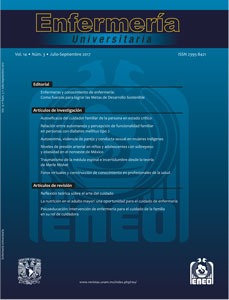Spinal cord injury and uncertainty from the perspective of Merle Mishel's theory
Main Article Content
Abstract
Objective: From the perspective of Mishel’s theory, to identify the levels of uncertainty in persons suffering from spinal cord injuries and the related associations with social and demographical characteristics.
Methods: This is a descriptive and transversal study. The Uncertainty from Illness instrument was applied on 107 persons suffering from spinal cord injuries. Univariate analysis was conducted to determine the social and demographical characteristics, and bivariate analysis was conducted to determine the associations between the level of uncertainty and the social and demographical characteristics as well as the components of the theory.
Results: From the studied sample, 96% were male and 4% female. The average age was 36 years old (range 19-59). The average time with the injury was 151 months. A significant association was found between the level of uncertainty and civil status, low education level, health social security regimen, and low cognitive capacity.
Conclusion: Nursing can provide integral rehabilitation which is centered on the special needs, on early education, and on a humanistic approach, so that persons suffering from spinal cord injuries can mold their uncertainty into positive coping with their life condition.
Publication Facts
Reviewer profiles N/A
Author statements
- Academic society
- N/A
- Publisher
- Universidad Nacional Autónoma de México
Article Details
Dimensions citation
MÉTRICAS
Enfermería Universitaria by Universidad Nacional Autónoma de México it is distributed under the License Creative Commons Attribution - NonCommercial - NoDerivatives 4.0 International
Accepted and published articles become open-access under the terms of the Creative Commons CC BY-NC-ND 4.0 license, which authorizes the reproduction and sharing without commercial purposes, provided the corresponding acknowledgments to their authors. Authors are allowed to manage a self-archive copy of the article’s published version so that they can open-access it in their personal or institutional web pages, and/or any other broad-diffusion space.



